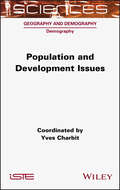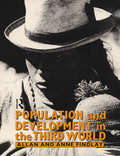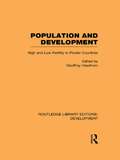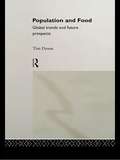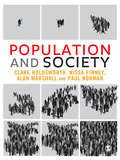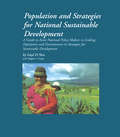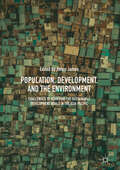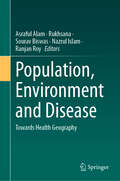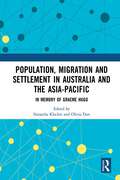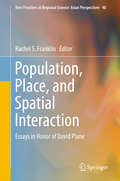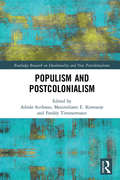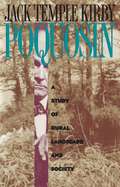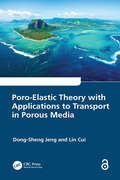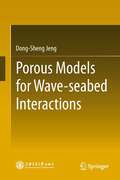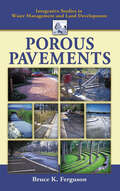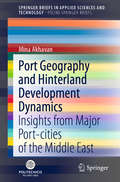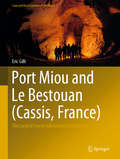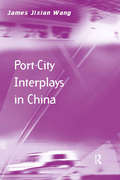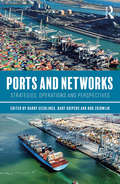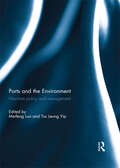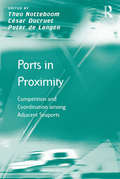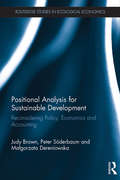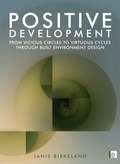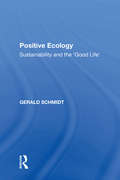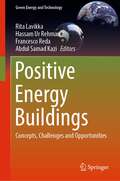- Table View
- List View
Population and Development Issues
by Yves CharbitOne of the major challenges facing the world today is the interaction between demographic changes and development. Rather than the usual view that the population itself is the main problem, Population and Development Issues argues that it is just one factor among many others, such as poverty, illiteracy, poor health, unemployment, the condition of women and climate change.This book analyzes the relationships between the key demographic variables (fertility, morbidity and mortality, migration, etc.) and major development issues, notably education, employment, health, gender, social and geographical inequalities and climate concerns. Bringing together contributions from specialists across every field, it presents empirical data simply and clearly alongside theoretical reflections.
Population and Development in the Third World (Routledge Introductions to Development)
by Allan M. Findlay Anne FindlayAllan and Anne Findlay argue that a nation's human population is a vital resource in the development process. Changes in its composition - increased life expectancy combined with a falling birth rate, for example - can have profound effects upon a society. Warfare and mass migration of male workers also have long-reaching effects on those left behind. The rapid growth of Third World populations has often incorrectly been identified as the major force preventing more rapid economic development. Population pressure has been known to generate technological breakthroughs. Their final chapter examines family planning programmes, and concludes by asking who benefits most from population policies and questioning the right of developed countries to advocate family planning programmes for Third World nations.
Population and Development: High and Low Fertility in Poorer Countries (Routledge Library Editions: Development)
by Geoffrey HawthornFirst published in 1978, this book explores the vital global issue of high and low fertility in poorer countries through a series of case studies by contemporary experts in the fields of development and demography. These studies examine such issues as: the relations between fertility rates and income distributions in poor societies; the question of whether or not neo-classical macro-economics are sufficient to understand and to try to engineer relations between economies and populations; and the specifics of the relations between fertility and a variety of socio-economic factors in both South Asia and West Africa. The point of the collection is to explain how very far general models can be taken, and to suggest that they cannot be taken as far as those who have tended to ignore the structural complexities of, and differences between, various societies have implied.
Population and Food: Global Trends and Future Prospects
by Tim DysonPopulation and Food examines recent trends in food production and assesses the prospects for feeding humanity in the twenty-first century. With case studies from throughout the developed and developing world, the book suggests that food production in most world regions has kept ahead of population growth, that future food production prospects are encouraging, and that in all probability the people of the world will be better fed in the twenty-first than in the twentieth century.
Population and Society
by Alan Marshall Paul Norman Dr Clare Holdsworth Nissa Finney"An excellent introduction to the study of population and its significance for many of the key social, political, cultural and environmental issues facing the world today. It covers population growth, ageing, migration and mobility, parenting, health inequalities, and much more... The authors do not shy away from areas of continuing debate, providing both sides of an argument and encouraging readers to follow up the original sources" - Tony Champion, Emeritus Professor of Population Geography, Centre for Urban, Regional & Development Studies, Newcastle University and Vice President, British Society for Population Studies, 2011-2013 Population and Society is an undergraduate introduction to population that explains the latest trends in population studies. The text provides a detailed and completely accessible overview that: situates demographic events - fertility, mortality and migration - within the context of broader social impacts and theorisations like social inequalities, individualisation and life course analysis uses global illustrative examples to demonstrate the importance of data and data interpretation in population studies is illustrated throughout with pedagogic features, like chapter opening summaries, suggestions for further readings and case study examples. This text will be widely used as the standard and most up-to-date text on population and society for courses across the social sciences.
Population and Strategies for National Sustainable Development: A guide to assist national policy makers in linking population and environment in strategies for development (Health And Population Set Ser.)
by Gayl D Ness Meghan V GolayThe guide serves as a resource for national-level policy makers and the staff of conservation organizations who wish to integrate population and environmental conditions in planning for sustainable development. It presents the basic rationale for linking population and environmental issues, including the demonstrable impact that growth in population and consumption is having on the environment. At the same time, it acknowledges the difficulty of achieving integration due to long-entrenched disciplinary and institutional specialization. The guide refrains from making blanket prescriptions, but rather emphasizes that policy and planning responses must be attuned to the location-specific nature of population-environment interactions. A number of mechanisms for achieving integration are presented, including placement of demographers within national planning organizations, or creation of country-based networks of population and conservation professionals who meet regularly to share knowledge and experience. For those less familiar with previous research, the book includes a primer on demographic change and models and frameworks for understanding the links between population dynamics (births, deaths, growth, migration) and environmental change.Originally published in 1996
Population, Development, and the Environment: Challenges to Achieving the Sustainable Development Goals in the Asia Pacific
by Helen JamesThis book takes the reader into some of the most intransigent social, economic, and political issues that impact achieving sustainable development in Asia and the Pacific. Through meticulous analysis of the integrated relationships between population, development, and the environment, the chapters in this volume investigate the impacts of hydropower development on fragile ecosystems; mining, landslides and environmental degradation; deforestation; water and food security; rural-urban migration, poverty alleviation, civil society and community empowerment; and how disaster recovery requires multi-scalar and multi-disciplinary approaches that take into account governance, culture, and leadership. Legal frameworks may be legislated, but are often rarely implemented.The book will be valuable to students of sustainability, population and development, and governmental policy advising sectors as well as the NGO and humanitarian sectors. The distinctive characteristic of this book is that it encapsulates an integrated, multi-disciplinary focus which brings to the discussion both robust empirical research and challenging policy applications in the investigation of how the sustainable development goals may be achieved in Asia and the Pacific.
Population, Environment and Disease: Towards Health Geography
by Ranjan Roy Nazrul Islam Rukhsana Asraful Alam Sourav BiswasThis book discusses a broad range of vital issues in public health, encompassing health facilities, the healthcare system, disease and epidemiological transition of disease, spatio-temporal change of health facilities, disease patterns, and the complex reciprocal relationship between human health and the environment. The book is arranged into three broad sections. Part I: Socio-demographic determinants of public health and policies; Part II: Spatio-temporal & environmental determinants of public health and policies; and Part III: Disease epidemics and challenges. Considering all these overarching themes, this book has been prepared to discuss and provide insights to generate awareness of the holistic perspective of social, cultural, and political factors for public health, disease, epidemics, health facilities, the healthcare system, government policies, prosperity and backdrops in global and local contexts as a geographical perspective. The book should attract the attention of students, researchers, academicians, policymakers and other inquisitive readers interested in different aspects of public health, health geography, and spatial demography.
Population, Migration and Settlement in Australia and the Asia-Pacific: In Memory of Graeme Hugo
by Natascha Klocker Olivia DunThe chapters in this book reflect on the work of seminal Australian geographer, the late Professor Graeme Hugo. Graeme Hugo was widely respected because of his impressive contributions to scholarship and policy in the fields of migration, population and development, which spanned several decades. This collection of works contains contributions from authors whose own research has been influenced by Hugo; and includes numerous authors who worked closely with Hugo throughout his career. The collection provides an opportunity to reflect on Hugo’s legacy, and also to foreground contemporary scholarship in his key areas of research focus. The chapters are organised into two thematic threads. Part I contains works relating to ‘Population, Migration and Settlement in Australia’, while Part II focuses on ‘Labour and Environmental Migration in the Asia-Pacific’. Together, these two thematic threads provide broad coverage of Graeme Hugo’s key areas of research focus. The chapters also serve as a reminder of Hugo’s steadfast concern with producing careful scholarship for the public good, and seek to prompt continued work in this vein. The chapters originally published in special issues in Australian Geographer.
Population, Place, and Spatial Interaction: Essays in Honor of David Plane (New Frontiers in Regional Science: Asian Perspectives #40)
by Rachel S. FranklinThis volume is devoted to the geographical—or spatial—aspects of population research in regional science, spanning spatial demographic methods for population composition and migration to studies of internal and international migration to investigations of the role of population in related fields such as climate change and economic growth. If spatial aspects of economic growth and development are the flagship of the regional science discipline, population research is the anchor. People migrate, consume, produce, and demand services. People are the source and beneficiaries of national, regional, and local growth and development. Since the origins of regional science, demographic research has been at the core of the discipline. Contributions in this volume are both retrospective and prospective, offering in their ensemble an authoritative overview of demographic research within the field of regional science.
Populism and Postcolonialism (Routledge Research on Decoloniality and New Postcolonialisms)
by Maximiliano E. Korstanje Adrián Scribano Freddy Alex Timmermann LópezThis book investigates the interconnections between populism and neoliberalism through the lens of postcolonialism. Its primary focus is to build a distinct understanding of the concept of populism as a political movement in the twenty-first century, interwoven with the lasting effects of colonialism. This volume particularly aims to fill the gap in the current literature by establishing a clear-cut connection between populism and postcolonialism. It sees populism as a contemporary and collective political response to the international crisis of the nation-state’s limited capacity to deal with the burst of global capitalism into everyday life. Writings on Ecuador, Colombia, Chile, Brazil, Italy, France and Argentina offer regional perspectives which, in turn, provide the reader with a deepened global view of the main features of the multiple and complex relations between postcoloniality and populism. This book will be of interest to sociologists, anthropologists and political scientists as well as postgraduate students who are interested in the problem of populism in the days of postcolonialism.
Poquosin
by Jack Temple KirbyJack Temple Kirby charts the history of the low country between the James River in Virginia and Albemarle Sound in North Carolina. The Algonquian word for this country, which means 'swamp-on-a-hill,' was transliterated as 'poquosin' by seventeenth-century English settlers. Interweaving social, political, economic, and military history with the story of the landscape, Kirby shows how Native American, African, and European peoples have adapted to and modified this Tidewater area in the nearly four hundred years since the arrival of Europeans. Kirby argues that European settlement created a lasting division of the region into two distinct zones often in conflict with each other: the cosmopolitan coastal area, open to markets, wealth, and power because of its proximity to navigable rivers and sounds, and a more isolated hinterland, whose people and their way of life were gradually--and grudgingly--subjugated by railroads, canals, and war. Kirby's wide-ranging analysis of the evolving interaction between humans and the landscape offers a unique perspective on familiar historical subjects, including slavery, Nat Turner's rebellion, the Civil War, agricultural modernization, and urbanization.
Poro-Elastic Theory with Applications to Transport in Porous Media
by Dong-Sheng Jeng Lin CuiThis book treats the subject of porous flow and its applications in three engineering and scientific problems. The first major part of the book is devoted to solute transport in unsaturated porous media. Dynamic hydraulic conductivity and degree of saturation associate with pore pressures are also included in the consolidation-induced solute transport process. The second part of this book focuses on tidal dynamics in coastal aquifers, including shallow water expansion for sloping beaches, two-dimensional problem in estuarine zone and leaky confined aquifers. The final part of the book summarizes the recent development of porous model in the field of liquefaction around marine infrastructures including fundamental mechanisms of momentary and residual seabed liquefaction, two-dimensional and three-dimensional porous models for fluid-seabed interactions around breakwaters, pipelines and piled foundations in marine environments. The authors’ aim is to describe in detail the applications of porous models for several engineering problems. This book will provide academic researchers and industry an overview of recent development in the field of porous models and the applications. The Open Access version of this book, available at http://www.taylorfrancis.com, has been made available under a Creative Commons Non Commercial-No Derivatives (CC-BY-NC-ND) 4.0 license. Funded by Qingdao University Technology, China
Porous Models for Wave-seabed Interactions
by Dong-Sheng Jeng"Porous Models for Wave-seabed Interactions" discusses the Phenomenon of wave-seabed interactions, which is a vital issue for coastal and geotechnical engineers involved in the design of foundations for marine structures such as pipelines, breakwaters, platforms, etc. The most important sections of this book will be the fully detailed theoretical models of wave-seabed interaction problem, which are particularly useful for postgraduate students and junior researchers entering the discipline of marine geotechnics and offshore engineering. This book also converts the research outcomes of theoretical studies to engineering applications that will provide front-line engineers with practical and effective tools in the assessment of seabed instability in engineering design. Prof. Dong-Sheng Jeng works at Shanghai Jiao Tong University, China.
Porous Pavements (Integrative Studies in Water Management & Land Development)
by Bruce FergusonPavements are the most ubiquitous of all man-made structures, and they have an enormous impact on environmental quality. They are responsible for hydrocarbon pollutants, excess runoff, groundwater decline and the resulting local water shortages, temperature increases in the urban "heat island," and for the ability of trees to extend their roots in
Port Geography and Hinterland Development Dynamics: Insights from Major Port-cities of the Middle East (SpringerBriefs in Applied Sciences and Technology)
by Mina AkhavanThis book illustrates and discusses the main characteristics of port-city development dynamics with a focus on the fast-growing city-states of the Middle East, which are emerging as key players in logistics and the global supply chain. Maritime ports and the cities hosting them have long fascinated scholars – geographers, economists, architects, urban planners, sociologists etc. – as they become centres of exchange where different social and urban environments meet, at the intersection between land and sea. Given that the current body of literature on the topic is biased – mainly concerning the Western world and East Asian region – with mono-disciplinary tendencies, this book outlines a theoretical basis from a wide range of literature, linking port-city studies, globalization theories and logistics, and adopts a multidisciplinary perspective. The main target audience of the book includes scholars and graduate students in urban studies, spatial planning, urban and regional economics, logistics, geography and transport geography with an interest in studying port geography and the port-city interface, port infrastructure development and port hinterland dynamics; it will also benefit policymakers and urban planners whose work involves these topics.
Port Miou and Le Bestouan: The Largest French Submarine Karst Springs (Cave and Karst Systems of the World)
by Eric GilliThis book documents the exploration and engineering history and potential of two submarine karst springs, Port Miou and Le Bestouan, from the 1970s until now. These springs are the outlets of a vast and deep karst aquifer of more than 1000 km2 near the city of Cassis, France. It presents the latest hypotheses for the hydrological and speleological models of this karstic network explaining the intrusion of saline waters within the system with further applications to other karstic springs in the Mediterranean.
Port-City Interplays in China (Transport And Mobility Ser.)
by James Jixian WangChina has progressed dramatically since 1978 when the country started its economic reforms and opened up to the world economy. It took only three decades for China to develop from a closed, centrally planned economy with little sea-borne trade into the world's second largest economy with the largest container shipment volume in the world. The major coastal cities have been gateways linking China with the world and have experienced rapid urbanization and port growth. How has such port growth been speeded up and realized under strong state control and intervention? How have ports and their cities affected each other? What lessons can China’s port-cities learn from other countries, regions and cities? What will be the next stage of port-city interplays in China in this globalizing era? Answering these questions from a geographical perspective, James Wang looks into four sets of port-city relations in China: Economic and functional relations between port and city; port-city spatial relations; external network relations of cities through ports; and port-city governance. These relations formulate a conceptual framework which is used to interpret port-city interplays in individual ports and cities but also in multi-port regions such as the Pearl River Delta. Based on the author’s own research and investigations into more than 25 port cities in China over the past 18 years, this book provides vivid stories about China and challenge existing theories on port development.
Ports and Networks: Strategies, Operations and Perspectives
by Harry Geerlings Bart Kuipers Rob ZuidwijkWritten by leading experts in the field, this book offers an introduction to recent developments in port and hinterland strategies, operations and related specializations. The book begins with a broad overview of port definitions, concepts and the role of ports in global supply chains, and an examination of strategic topics such as port management, governance, performance, hinterlands and the port-city relationship. The second part of the book examines operational aspects of maritime, port and land networks. A range of topics are explored, such as liner networks, finance and business models, port-industrial clusters, container terminals, intermodality/synchromodality, handling and warehousing. The final section of the book provides insights into key issues of port development and management, from security, sustainability, innovation strategies, transition management and labour issues. Drawing on a variety of global case studies, theoretical insights are supplemented with real world and best practice examples, this book will be of interest to advanced undergraduates, postgraduates, scholars and professionals interested in maritime studies, transport studies, economics and geography.
Ports and the Environment: Maritime Policy and Management
by Meifeng Luo and Tsz Leung YipPorts are a vital part of the global economy, connecting the world through maritime transport networks, promoting international trade, and supporting global economic growth. However, port communities are increasingly concerned about the local environmental problems associated with air pollution from increased port activities. Efforts are increasingly being made into the reduction of human-induced changes to the global environment, and one of the target areas is to reduce air emissions from international shipping. It appears that management of the port sector has entered into a new era, not only because environmental concerns are increasingly being expressed surrounding the ports themselves, but also because many of the new environmental measures associated with the shipping trade have to be enforced when ships are in port. Ports and the Environment assembles research focusing on the management of ports, and the environmental issues associated with both the shipping trade and the ports themselves. By examining contemporary concerns from the perspectives of maritime policy, port management, and industrial efficiency, this book will be provide important reference for future research and policy-making in this area. This book was originally published as a special issue of Maritime Policy & Management.
Ports in Proximity: Competition and Coordination among Adjacent Seaports (Transport And Mobility Ser.)
by César DucruetPorts in Proximity provides an overview of key contemporary research in the field through a broad range of international case studies. The concepts of strategic management, supply chain management, port and transport economics and economic and transport geography are applied throughout the book to offer an in-depth understanding of the processes underlying spatial and functional dynamics in port systems. The opportunities for cooperation between competing adjacent ports is examined while the avenues for further joint research are identified, setting an agenda for further study.
Positional Analysis for Sustainable Development: Reconsidering Policy, Economics and Accounting (Routledge Studies in Ecological Economics)
by Judy Brown Peter Soderbaum Malgorzata DereniowskaClimate change, biodiversity loss, pollution of land and water, land-use changes, lack of equality and other problems at local, national and global levels represent a challenge for economics as a social science. Mainstream neoclassical economics may be able to contribute to a more sustainable society but it has also played a dominant role in a period where problems have been aggravated. A pluralist and democratic view of economics is therefore very much warranted. This book presents a multidimensional and ideologically more open view of economics: understanding economics in multidimensional terms is in accordance with the 17 sustainable development goals recognized by nations at the UN-level in 2015. Accordingly, approaches to decision making and accounting at the national- and business levels have to be reconsidered. Neoclassical Cost-Benefit Analysis (CBA) with focus on the monetary dimension and an assumed consensus about a specific market ideology to be applied is not compatible with democratic societies where citizen and actors in other roles normally differ with respect to ideological orientation. Environmental Impact Statements and Multi-Criteria methods are used to some extent to broaden approaches to decision-making. In this book, Positional Analysis is advocated as a multidimensional and ideologically open approach. Positional Analysis is based on a political economic conceptual framework (as part of ecological economics) that differs from neoclassical ideas of individuals, firms and markets. And since approaches to decision-making and to accounting are closely connected, a new theoretical perspective in economics similarly raises issues of how national and business accounting can be opened up to meet present demands among various actors in society. This perspective raises also numerous ethical questions at the science and policy interface that need to be properly addressed for sustainability decision making.
Positive Development: From Vicious Circles to Virtuous Cycles through Built Environment Design
by Janis BirkelandJanis Birkeland presents the innovative new paradigm of 'Positive Development' in which the built environment provides greater life quality, health, amenity and safety for all without sacrificing resources or money. With a different form of design, development itself can become a 'sustainability solution'. A cornerstone of this new paradigm is the eco-retrofitting of the vast urban fabric we already inhabit. The author presents a revolutionary new tool called SmartMode to achieve this end. This book challenges everyone working in or studying the areas of sustainable development, planning, architecture or the built environment to rethink their current ideas and practices.
Positive Ecology: Sustainability and the 'Good Life' (Ashgate Studies In Environmental Policy And Practice)
by Gerald SchmidtUntil recently, there has been a widespread view that we must give up amenities of modern life in order to achieve environmental sustainability. While newspapers and other popular media tend to focus on the negative aspects of environmental change, this volume examines the alternative notion of 'positive ecology'. Initially gleaned from the orientation of 'positive psychology', this argues that environmental science has been all too focused on analysing negative 'pathologies' and forgetting to provide more positive analysis and activism for sustainability. Bringing together a wide range of 'positive ecology' orientated case studies for the first time, the book discusses the wider contexts of how humanity is dependent on a functioning, biodiverse ecosphere of which we are only one part. It provides an original and previously undervalued approach to sustainability, and suggests that work towards sustainability is not only a necessity for our children's future, but necessary, sensible and meaningful in the present.
Positive Energy Buildings: Concepts, Challenges and Opportunities (Green Energy and Technology)
by Francesco Reda Rita Lavikka Hassam Ur Rehman Abdul Samad KaziThis book investigates positive energy buildings (PEBs). It provides and describes them, explains why they are important in the fight against climate change and discusses how they might be implemented. This book begins by contextualizing PEBs, discussing concepts, definitions and how they may be included by planning authorities in development plans. It then thoroughly explains what PEBs are and their impact on a climate-neutral economy. The book discusses technological, economic, societal and regulatory challenges and opportunities in employing PEBs, before concluding with possible scenarios for implementing them. This book is of use to researchers, practitioners, and policy makers interested in local and decentralized energy, as well as plans to achieve carbon neutrality.
